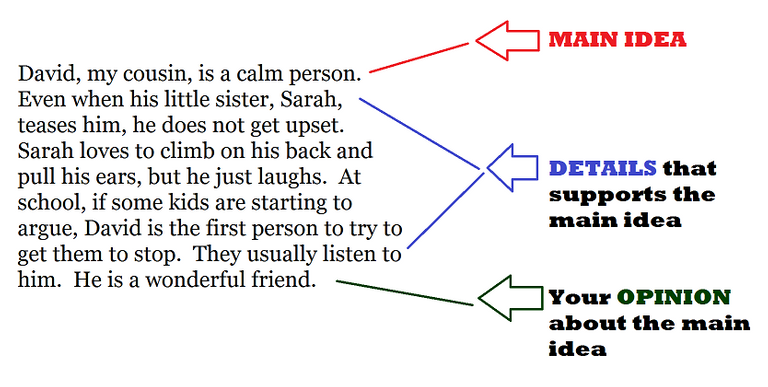When you write about a person, organize your ideas into a paragraph. A paragraph is a group of sentences about one idea.
- The first sentence tells a paragraph's main idea.
- Then a few sentences give details about the main idea. Details are facts about the main idea.
- Finally, the last sentence may give a writer's opinion of the main idea.
Thus, a paragraph is like a CHEESEBURGER:
It is important to think about and plan a description of a person before you start writing. Character qualities are words that tell us what kind of person someone is. One type of character quality tells how someone acts with others. Character qualities also tell what a person is like most of the time.
Look at how the following description of David is organized. Notice that his name and character quality (the main idea) are in the first sentence. The second and third sentences describe a detail about the main idea. The fourth and fifth sentences describe another detail. The last sentence tells the author's opinion of David:
Be sure to notice how the second and third sentences describe one detail that backs up the main idea. Sentences four and five describe a different detail that backs up the same main idea.
Exact words:
Words that say just what a writer means and give clearer information that other words.

These are examples of exact nouns and adjectives. See how the exact words make it easier to picture what is being described:
FIRST DRAFT:
The first draft is a chance to get your ideas down on paper. Do not worry about making mistakes. You can correct them later when you revise and proofread your description.
If many of your sentences start the same way, your writing may sound boring. A way to sound more interesting is to begin sentences with different words. It is important when writing about a person to begin sentences with words that are not the person's name or he or she.
These examples show how to start sentences in different ways:
Example 1:
These sentences repeat their beginnings:
Simon likes to work with tools. Simon helps his father in the workshop on Saturdays.
After revision, these sentences could be:
Simon likes to work with tools. He helps his father in the workshop on Saturdays.
Example 2:
The same sentences from Example 1, after revision, could be:
Simon likes to work with tools. On Saturdays, Simon helps his father in the workshop.
OR
Simon likes to work with tools. On Saturdays he helps his father in the workshop.
OR
Because Simon likes to work with tools, he helps his father in the workshop on Saturdays.
REVISION:
When you revise, you improve your work. Changing sentence beginnings is one part of the revision step. There are also other ways to improve your draft. You can add, take out, and rearrange words.
PROOFREADING:
Proofread your work to correct mistakes. Use standard editing marks to make changes. Make sure that you have started sentences with capital letters, completed all sentences, that words are spelled correctly and that each sentence ends with correct punctuation.
PUBLISH:
After you proofread, you are ready to put your draft into a final form that the reader will enjoy. You will be proud when your published draft is neat, has no mistakes, and is beautiful to look at. Complete your draft by adding a title that includes the name of the person you are describing.






Congratulations @bdmomuae! You have completed the following achievement on the Steem blockchain and have been rewarded with new badge(s) :
You can view your badges on your Steem Board and compare to others on the Steem Ranking
If you no longer want to receive notifications, reply to this comment with the word
STOPVote for @Steemitboard as a witness to get one more award and increased upvotes!
To write a college essay a college essay, you must follow certain guidelines. For example, you should make sure your opening paragraph answers the question directly. The body of the essay should then elaborate on your answer. The body should be concise and coherent, and the essay must not include irrelevant information. It should also be written in your own voice so it sounds natural.